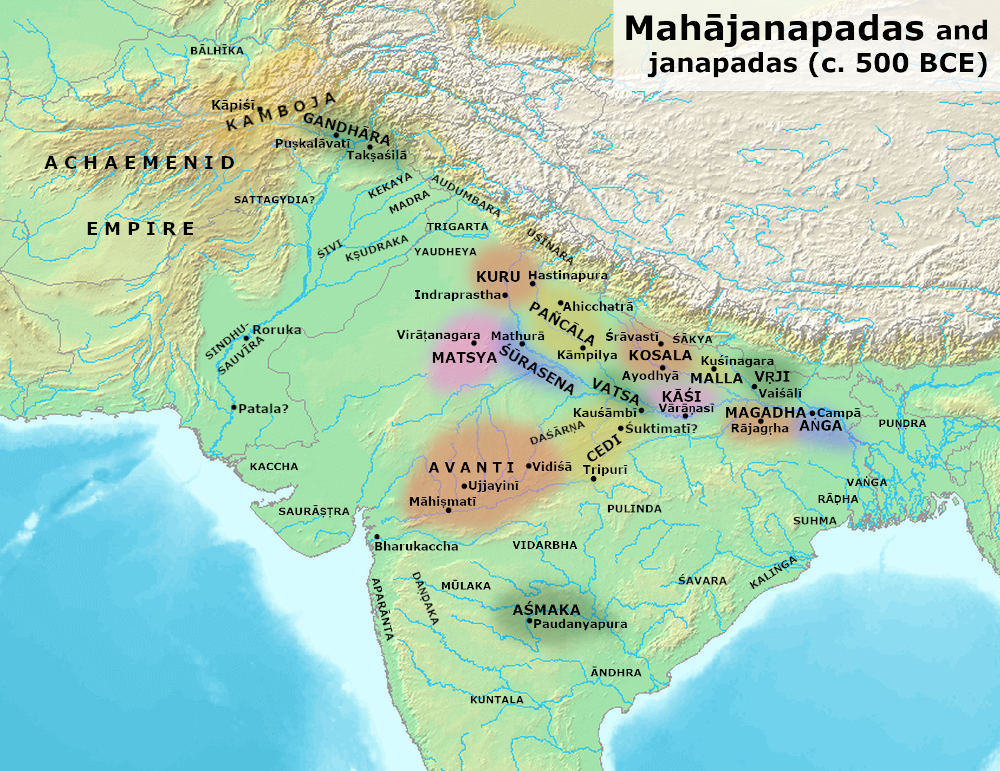Table of Contents

Introduction: 16 Mahajanpadas
The Sixteen Mahajanapadas were prominent ancient kingdoms that existed in the Indian subcontinent during the 6th to 4th centuries BCE, a period marked by significant socio-political development.
These Mahajanapadas are frequently referenced in ancient Indian literature, including Buddhist and Jain texts like the Anguttara Nikaya and the Bhagavati Sutra, as well as epic narratives such as the Mahabharata.
Each Mahajanapada functioned as a major political and economic hub, with distinct cultural identities and governance structures.
These states were often located near fertile river valleys and strategic trade routes, enhancing their economic prosperity and political influence.
The capitals of these Mahajanapadas, such as Rajagriha in Magadha, Vaishali in Vajji, and Taxila in Gandhara, were vibrant centers of learning and culture.
The dynamic interactions between these kingdoms, through warfare, alliances, and diplomacy, significantly shaped the historical and cultural landscape of ancient India.
Important Points: Sixteen Mahajanpad

- Definition:
- Mahajanapadas are ancient Indian kingdoms or republics that existed between the 6th and 4th centuries BCE.
- Mahajanapadas were the amalgamation of a large number of rural and urban settlements.
- There were 16 mahajanpadas.
- Mention in Buddhist Texts: The names of 16 mahajanapadas are mentioned in the Buddhist text Anguttara Nikaya (part of Sutta Pitaka).
- Mention in Jain Texts: The Jaina text Bhagwati Sutra and another Buddhist text Mahavastu also have the names of the 16 Mahajanapadas.
- Political Structure: The Mahajanapadas were either monarchial or republican.
- Geographical Distribution:
- Most of these Mahajanpadas were situated in Bihar, Uttar Pradesh, and central India while in southern India there was only one Mahajanapada – Asmaka.
- The whole Punjab region had only two Mahajanapada Gandhara and Kuru.
- Assam, Bengal, Orissa, Gujrat, Sindh, and the far South had no Mahajanapada at all.
Types of Mahajanpad
Mahajanapadas were of two types:
| The Monarchial States | Anga, Avanti, Asmaka, Chedi, Kashi, Kosala, Gandhara, Magadha, Matsya, Shursena, Vatsa |
| Non-Monarchial/Republican States | Kamboj, Kuru, Koliyas, Malla, Moriya, Shakya, Vajji, Panchal, Licchavis, Bhaggas, Videhas |
Sixteen Mahajanpad with Capital
| Mahajanapad | Details |
|---|---|
| Anga Capital – Champa | It was a great center of trade and commerce and it had trade relations with Suvarnabhumi. Anga was conquered and annexed by Magadha in the time of Bimbisara. |
| Kosala Capitals – Shravasti (Capital of Northern Kosala) Kusavati (Capital of Southern Kosala) | The most popular king was Prasenjit. He was a contemporary and friend of Buddha. |
| Kashi Capital – Varanasi | Famous for Cotton Textiles and market for horses. |
| Magadha Capital – Girivraja | Modern districts of Patna and Gaya in southern Bihar and parts of Bengal in the east. Active centre of Jainism in ancient times. |
| Vajji Capital – Vaishali | Modern-day Mithila region in northern Bihar. |
| Malla Capital – Pavapuri | Modern-day Gorakhpur region. |
| Chedi Capital – Suktimati | Eastern parts of modern Bundelkhand. |
| Vatsa Capital – Kaushambi | Situated around modern-day Allahabad in Uttar Pradesh. |
| Kuru Capital – Hastinapur | Modern-day Delhi-Meerut region.• Initially it was a monarchy but later it became a republic. |
| Panchal Capital – Ahichchhatra (Capital of North Panchal) Kampilya (Capital of South Panchal) | Corresponds to the modern-day Badaun, Farrukhabad, and adjoining districts of U.P. |
| Matsya Capital – Viratnagara | Corresponds to the modern-day region of Jaipur. |
| Surasena Capital – Mathura | King Avantiputra of Surasena was the first among the chief disciples of Buddha. |
| Asmaka Capital – Potana or potali | It was located on the banks of river Godavari. |
| Avanti Capital – Ujjain (Capital of North Avanti) Mahishmati (Capital of South Avanti) | Located around the region of Ujjain district in Madhya Pradesh. Chanda Pradyota was the most powerful king of Avanti. |
| Gandhara Capital – Taxila | Modern-day region of Peshawar and Rawalpindi. Famous for education and learning. Gandhari was the princess of this state. Panini and Kautilya are great scholars of Taxila University. |
| Kamboja Capital – Rajapura | According to Kautilya’s Arthashastra and Ashoka’s Edict No. XIII Kambojas followed the republican Constitution. |
